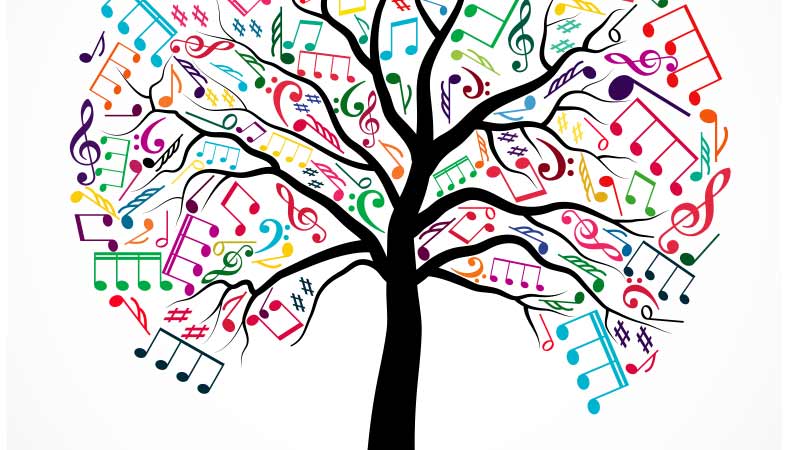
Music can improve muscle function, immunity, the mind, and virtually everything in between. But beware of the pitfalls that include propaganda, and mind-altered shopping.
“If music be the food of love, play on.” Shakespeare
Like delicious food, sex — and even some drugs like caffeine — playing or listening to good music can stimulate the mind and body, producing feel-good chemicals including dopamine, endorphins, and endocannabanoids.
Humans created music early in their existence, and it’s been a component of virtually all cultures up to the most advanced. Likewise, throughout an individual’s lifespan, as the Harvard Health Publishing (Music and Health, July 2011) newsletter states: “In tune or not, we humans sing and hum; in time or not, we clap and sway; in step or not, we dance and bounce.” And, “The human brain and nervous system are hard-wired to distinguish music from noise and to respond to rhythm and repetition, tones and tunes.”
While music has always had an intrinsic therapeutic response, the view on its use as a therapy is evolving. Writing in the medical journal Frontiers of Psychology, Leubner and Hinterberger state that, “Music therapy often comes into play when other forms of treatment are not effective enough or fail completely.”
The reason we listen to music is because we love it. Music makes our minds a better place. And that has profound therapeutic effects, although we should not have to wait for a symptom to get music therapy.
Sour Notes
While music’s influence on cognition, behavior, and creativity is long known, so is music’s power in movies, stores and malls, relaxing shoppers by temporarily taking them away from the stress of life. It’s a powerful mind-altering effect. Music has also been used in a nationalistic way to rally warring troops. Advertisers have long paid attention to this motivational use with great success, encouraging people to buy. The creation of well-crafted jingles — even those we don’t like — steer us, like zombies, to spend money under its influence. The use of snippets of popular songs are used too, very successfully. (If I get under that influence, I remedy it by thinking of a 1970 Paul McCartney song: “Buy buy says the sign in the shop window, why why says the junk in the yard.” I am my brain on music.)
We need to be aware of certain types of music that can be damaging. Some modern music has been debased to the point its natural therapeutic benefits are pushed aside or eliminated. The dopamine response is displaced by displeasure. The snippets of some songs we hear most today are the annoying online buzzing of ads, mall music and what used to be referred to as elevator music (we still have that, too). While sometimes popular, this music can be painful to the brain.
This bad music is like junk food, and it should be eliminated as much as possible, and replaced by the music we love. As mentioned we are hard-wired to distinguish music from noise and if your first response to “music” is to turn it off or get out of the room, there’s a good chance your brain is trying to tell you something.
The Best Music
It’s important to listen to a variety of music you like — classical, rock, rap, folk, reggae jazz. It’s also important to experiment. In addition to hearing music we’re familiar with, listening to new sounds can be very valuable — the brain loves new things, and we may find more favorites.
Listening to the music we loved in our youth also can be particularly enjoyable, and powerfully therapeutic. Even those with memory loss respond to these songs. Music can turn on the brains of those with Alzheimer’s disease and other serious conditions of cognitive impairment. Working with Alzheimer’s patients, Neurologist Dr. Oliver Sachs says “Music imprints itself on the brain deeper than any other human experience. Music brings back the feeling of life when nothing else can.”
As studies show, when music stimulates the brain, the body responds too. It can help reduce pain, depression, and anxiety, improve cardiovascular health, support sleep, stabilize balance and gait, help hormones and immunity, relieve PTSD and improve self-esteem. Athletes, may benefit too, as can hospitalized patients, and those having surgery or other therapies.
Not just listening, but playing music may be even more powerful, as can dancing to it too, and watching music videos. One large study showed that people who attended concerts obtained additional benefits.
“If I were not a physicist, I would probably be a musician. I often think in music. I live my daydreams in music. I see my life in terms of music.” – Albert Einstein
The Natural Therapy
For those who don’t love music, it poses a problem because of the missed opportunity for natural therapy and simple source of daily joy. Sometimes this is because we have not found the kind of music we love, but more often it’s due to a distaste for music, often due to some type of brain injury or a “software” problem that can be remedied with retraining.
A more serious disorder, amusia, is a condition in people who have problems processing music-related pitch, emotion, memory and recognition. Being “tone deaf” is an example. It’s best seen as a spectrum with more mild symptoms in many people, and with the ability to correct the problem. Here are three examples:
- Muscles and rhythm. An example of muscles working well with music is illustrated by rhythm. Whether toe-tapping, head bobbing, or dancing, music makes the brain move the body. Some people, however, have an impairment in the cerebellum where rhythm originates, rendering them less able to keep a beat. Retraining the brain can be accomplished by marching to the beat of a metronome, which makes an audible beat set to a certain tempo. Marching to a beat seems easy enough, but those with this type of brain dysfunction can’t do it easily, or even at all. A small hand-held metronome or phone app, is all you need. Set the tempo to a comfortable beat, such as 80 or more beats per minute, and start marching — or walking or running — in step to the beats. Try it at home first, then incorporate it in your workout for added benefit [LINK]. As you warm up and move faster, increase the tempo, maybe to 100 or more. If it seems difficult at first, it could quickly get easier. After a few sessions, it should be much easier. If it’s not, start with slower walking and fewer beats per minute. Some people only need a week or two, others more, before the full workout, from slow beats to fast then slow again, is automatic. Maintaining the rhythmic ability is easy if you listen to music regularly.
- Lyrical Challenges. Some people are not able to hear all, or any, words sung in songs. Most music is produced so the lyrics are easily understood, and most people can. This problem may not seem significant, but it may indicate other brain areas are not as functional. The remedy may be relatively simple. Find the lyrics of a song (easy to do online), and read them to yourself — reading along while listening to the song. Do this two or three times, then use other songs over a period of a few days. After a week or so, test yourself by listening to a song without the lyrics. Usually, it’s possible to begin hearing lyrics more clearly, and if it’s not working yet continue the treatment. (This can help other areas of the brain work better too, as the therapy brings more blood, with oxygen and other nutrients, into the brain.)
- Wave Lengths. Normally, listening to music can change our state of consciousness to produce alpha waves, which are relaxing, dreamy, and, literally, therapeutic because they reduce stress hormones, improve blood sugar, even balance muscles. It not only brings joy and a better mood, but a better brain. Some people, however, don’t respond this way to music. The cause may be from impaired neck muscles, some of which are vital to brain function. It may be due to an old injury, like a whiplash, or other chronic problem, impairing the brain’s ability to make adequate, or any, therapeutic alpha waves. Correcting the problem can restore alpha wave production. This usually means finding a practitioner who can determine which muscles are at fault and provide a therapy to correct them, with various forms of biofeedback working well.
- Singing a cure. Some people do not sing well because they were not exposed to music early in life or possibly due to a brain injury. The more obvious example of this is a condition called aprosodia, which can occur after a head trauma, stroke or in neurological diseases like Parkinson’s.
Mild forms of aprosodia can be recognized in many people, some cases worse than others, and can significantly affect communication and other social skills, and is associated with stuttering. Fortunately, much can be done to address the problem. For example, adding more musical sense of rhythm and pitch variation to a sentence can often eliminate a stutter. Likewise, “singing” our conversations may help us overcome aprosodia-like symptoms to help with better communication, especially in portraying emotion, emphasis and humor.
Why We Love Certain Songs
Why do we listen to the same songs over and over? First, it’s because we love them, and they make us feel good. We often imagine hearing them over and over, or sometimes, out of the blue, we find ourselves humming or singing a song we have not heard for years, realizing we love that song. And, when hearing that actual song again, we may hear more of it than we remember — notes, lyrics or other musical components we didn’t realize were there before. This process is a huge reward for the brain. It’s why some of us listen to the Beatles, Bob Dylan or Bach many times over. Even though we’ve heard the songs hundreds of times, there’s still something new about them.
Listening works best through good speakers, headphones or earbuds; this is when we might hear something previously unheard — even after hundreds or thousands of listens. The more music we hear, new and old, the better our brains work, as one area of increased brain activity circulates more blood to potentially help other areas.
Another reason we listen to songs over and over is because they bring up memories. Hearing songs from certain times in our lives is powerful, they make us revisit the good times. Hearing the songs from the summer of love, or coming of age, or those fun college days — they not only make us feel good, they literally make us physiologically younger, as studies have shown.
There’s also something psychologically, and socially, associated with many songs. Most songwriters are not the normal 9-5 corporate workers, but are rebels at heart; non-conformists who healthfully break rules that many others want to break but don’t. (Harvard’s Francesca Gino writes about this in her new book, “Rebel Talent: Why It Pays to Break the Rules in Work and Life.”) Revolutionary thought is typical of true songwriting (as opposed to phony industry-written songs), as well as other artistic endeavors. As a result, the feeling a song can evoke can lead people to let go of norms and traditions that may not be healthy, to uncover that “other” person in the subconscious mind, and release creative thinking and an amazing feeling of freedom — a better brain. Literally, music makes our mind a better place.








